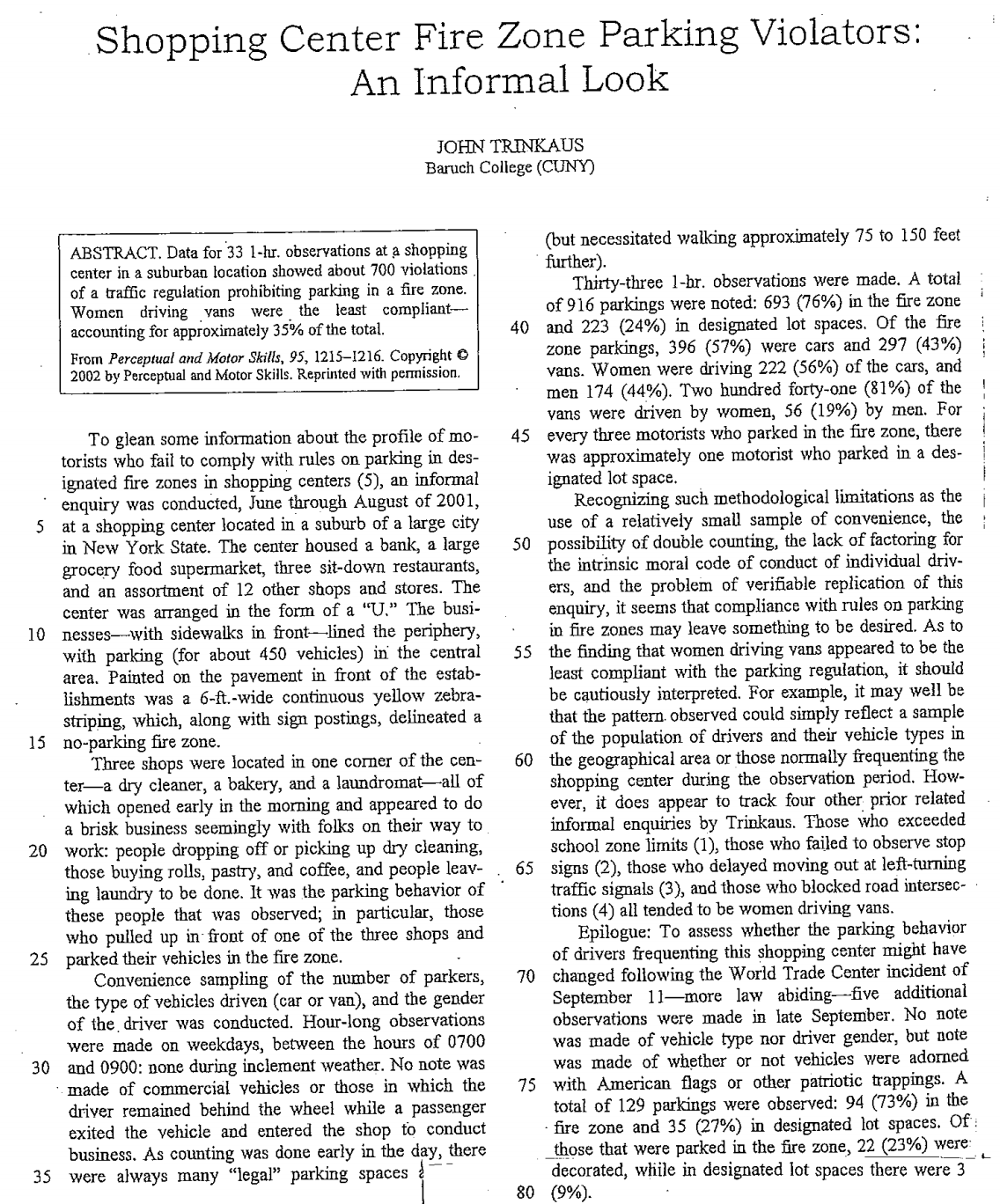Principles Of Marketing
17th Edition
ISBN:9780134492513
Author:Kotler, Philip, Armstrong, Gary (gary M.)
Publisher:Kotler, Philip, Armstrong, Gary (gary M.)
Chapter1: Marketing: Creating Customer Value And Engagement
Section: Chapter Questions
Problem 1.1DQ
Related questions
Question
What type of descriptive research is used in this article? Explain/support your answer.

Transcribed Image Text:Shopping Center Fire Zone Parking Violators:
An Informal Look
JOHN TRINKAUS
Baruch College (CUNY)
(but necessitated walking approximately 75 to 150 feet
further).
Thirty-three 1-br. observations were made. A total
of 916 parkings were noted: 693 (76%) in the fire zone
40 and 223 (24%) in designated lot spaces. Of the fire
zone parkings, 396 (57%) were cars and 297 (43%)
vans. Women were driving 222 (56%) of the cars, and
men 174 (44%). Two hundred forty-one (81%) of the
vans were driven by women, 56 (19%) by men. For
45 every three motorists who parked in the fire zone, there
was approximately one motorist who parked in a des-
ignated lot space.
Recognizing such methodological limitations as the
use of a relatively small sample of convenience, the
50 possibility of double counting, the lack of factoring for
the intrinsic moral code of conduct of individual driv-
ers, and the problem of verifiable replication of this
enquiry, it seens that compliance with rules on parking
in fire zones may leave something to be desired. As to
55 the finding that women driving vans appeared to be the
least compliant with the parking regulation, it should
be cautiously interpreted. For example, it may well be
that the pattern. observed could simply reflect a sample
of the population of drivers and their vehicle types in
60 the geographical area or those normally frequenting the
shopping center during the observation period. How-
ever, it does appear to track four other prior related
informal enquiries by Trinkaus. Those who exceeded
school zone limits (1), those who failed to observe stop
65 signs (2), those who delayed moving out at left-turning
traffic signals (3), and those who blocked road intersec-
tions (4) all tended to be women driving vans.
Epilogue: To assess whether the parking behavior
of drivers frequenting this shopping center might have
70 changed following the World Trade Center incident of
September 11-more law abiding-five additional
observations were made in late September. No note
was made of vehicle type nor driver gender, but note
was made of whether or not vehicles were adorned
75 with American flags or other patriotic trappings. A
total of 129 parkings were observed: 94 (73%) in the
fire zone and 35 (27%) in designated lot spaces. Of:
those that were parked in the fire zone, 22 (23%) were:
decorated, while in designated lot spaces there were 3
80 (9%).
ABSTRACT. Data for 33 1-hr. observations at a shopping
center in a suburban location showed about 700 violations
of a traffic regulation prohibiting parking in a fire zone.
Women driving vans
accounting for approximately 35% of the total.
From Perceptual and Motor Skills, 95, 1215–1216. Copyright O
2002 by Perceptual and Motor Skills. Reprinted with permission.
were the least compliant-
To glean some information about the profile of mo-
torists who fail to comply with rules on parking in des-
ignated fire zones in shopping centers (5), an informal
enquiry was conducted, June through August of 2001,
at a shopping center located in a suburb of a large city
in New York State. The center housed a bank, a large
grocery food supermarket, three sit-down restaurants,
and an assortment of 12 other shops and stores. The
center was arranged in the form of a "U." The busi-
10 nesses-with sidewalks in front–lined the periphery,
with parking (for about 450 vehicles) in the central
area. Painted on the pavement in front of the estab-
lishments was a 6-ft.-wide continuous yellow zebra-
striping, which, along with sign postings, delineated a
15 no-parking fire zone.
5
Three shops were located in one corner of the cen-
ter-a dry cleaner, a bakery, and a laundromat-all of
which opened early in the morning and appeared to do
a brisk business seemingly with folks on their way to
20 work: people dropping off or picking up dry cleaning,
those buying rolls, pastry, and coffee, and people leav-
ing laundry to be done. It was the parking behavior of
these people that was observed; in particular, those
who pulled up in front of one of the three shops and
25 parked their vehicles in the fire zone.
Convenience sampling of the number of parkers,
the type of vehicles driven (car or van), and the gender
of the driver was conducted. Hour-long observations
were made on weekdays, between the hours of 0700
30 and 0900: none during inclement weather. No note was
made of commercial vehicles or those in which the
driver remained behind the wheel while a passenger
exited the vehicle and entered the shop to conduct
business. As counting was done early in the day, there
35 were always many "legal" parking spaces
Expert Solution
This question has been solved!
Explore an expertly crafted, step-by-step solution for a thorough understanding of key concepts.
Step by step
Solved in 3 steps

Recommended textbooks for you

Principles Of Marketing
Marketing
ISBN:
9780134492513
Author:
Kotler, Philip, Armstrong, Gary (gary M.)
Publisher:
Pearson Higher Education,

Marketing
Marketing
ISBN:
9781259924040
Author:
Roger A. Kerin, Steven W. Hartley
Publisher:
McGraw-Hill Education

Foundations of Business (MindTap Course List)
Marketing
ISBN:
9781337386920
Author:
William M. Pride, Robert J. Hughes, Jack R. Kapoor
Publisher:
Cengage Learning

Principles Of Marketing
Marketing
ISBN:
9780134492513
Author:
Kotler, Philip, Armstrong, Gary (gary M.)
Publisher:
Pearson Higher Education,

Marketing
Marketing
ISBN:
9781259924040
Author:
Roger A. Kerin, Steven W. Hartley
Publisher:
McGraw-Hill Education

Foundations of Business (MindTap Course List)
Marketing
ISBN:
9781337386920
Author:
William M. Pride, Robert J. Hughes, Jack R. Kapoor
Publisher:
Cengage Learning

Marketing: An Introduction (13th Edition)
Marketing
ISBN:
9780134149530
Author:
Gary Armstrong, Philip Kotler
Publisher:
PEARSON


Contemporary Marketing
Marketing
ISBN:
9780357033777
Author:
Louis E. Boone, David L. Kurtz
Publisher:
Cengage Learning